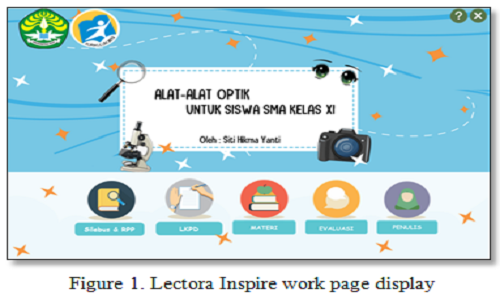
Improving the Understanding of Students' Learning Concepts on Optical Equipment Materials through Interactive Learning Media
Abstract
Keywords
Full Text:
PDFReferences
Duffin, J. M., & Simpson, A. P. (2000). A search for understanding. The Journal of Mathematical Behavior, 18(4), 415-427.
Fariyani, Q., & Rusilowati, A. (2015). Pengembangan four-tier diagnostic test untuk mengungkap miskonsepsi fisika siswa sma kelas x. Journal of Innovative Science Education, 4(2), 41-49.
Gunawan, G., Harjono, A., Sahidu, H., & Sutrio, S. (2014). Penggunaan multimedia interaktif dalam pembelajaran fisika dan implikasinya pada penguasaan konsep mahasiswa. Jurnal Pijar Mipa, 9(1), 15-19.
Gunawan, G., Harjono, A., & Sahidu, H. (2016). Laboratorium Virtual Fisika dan Implikasinya pada Penguasaan Konsep Optik Mahasiswa. dalam Prosiding SNFA (Seminar Nasional Fisika dan Aplikasinya). 1, 65-70.
Handayani, N. D., Astutik, S., & Lesmono, A. D. (2018). Identifikasi Miskonsepsi Siswa Menggunakan Four-Tier Diagnostic Test Pada Materi Hukum Termodinamika Di SMA Bondowoso. Jurnal Pembelajaran Fisika, 7(2), 189-195.
Primadona, H. (2018). Perbandingan Motivasi Belajar Siswa Dengan Menggunakan Media Lectora Inspire Dan Powerpoint Pada Materi Momentum Dan Impuls Kelas X Sman 3 Muaro Jambi. Edufisika, 3(1), 43-54.
Mas’ud, M. (2012). Membuat Multimedia Pembelajaran dengan Lectora. Yogyakarta: Pustaka Shonif.
Munawaroh, R. (2016). Identifikasi miskonsepsi siswa dan penyebabnya pada materi alat optic menggunakan three-tier multiple choice diagnostic test. Jurnal Inovasi Pendidikan Fisika (JIPF). 5(2), 79–81.
Nara, Y. (2018). Action research for improving the risk literacy of university students: Focusing on the effectiveness of risk communication using Crossroad game. Procedia computer science, 126, 2219-2227.
Ngubaidillah, A., & Kartadie, R. (2018). Pengaruh Media Visual Menggunakan Aplikasi Lectora Inspire Terhadap Hasil Belajar Peserta Didik. Jurnal Penelitian Pendidikan.
Putri, H. K., & Mahardika, I. K. (2016). Model Pembelajaran Inkuiri Terbimbing Disertai Teknik Peta Konsep dalam Pembelajaran Fisika di SMA. Jurnal Pembelajaran Fisika, 4(4), 321-326.
Rasiman, R., Rozana, E., & Sugiyanti, S. (2018). Efektivitas Model Pembelajaran Concept Attainment dan Model Pembelajaran Guided Discovery Berbantuan Lectora Terhadap Kemampuan Pemahaman Konsep Matematika. Jurnal Ilmiah pendidikan matematika, 3(2), 134-139.
Riduwan.2012. metode dan teknik menyusun proposal penelitian. Bandung, Alfabeta.
Sarabando, C., Cravino, J. P., & Soares, A. A. (2014). Contribution of a computer simulation to students’ learning of the physics concepts of weight and mass. Procedia Technology, 13, 112-121.
Setyo, Muryo dan Yuswono, C. Lilik. (2015). Pengaruh Penggunaan Media Pembelajaran Berbasis Lectora Inspire Terhadap Motivasi Belajar dan Hasil Belajar Siswa Kelas X Pada Standar Kompetensi Menggunakan Alat-alat Ukur di Jurusan Teknik Kendaraan Ringan SMK Muhammadiyah 1 Bantul: Studi Pendidikan Teknik Otomotif. Yogyakarta. Jurnal Pendidikan Otomotif, 9(1), 154-160.
Sulaeman, N. F., Laili, K dan Siska, M. F. (2018). Analysis of High School Student’s Misconception in Energy Using Ordered and Reasoning Multiple Choice. Jurnal Pembelajaran Fisika, 7(2), 202-209.
Suparno, P. (2013). Miskonsepsi dan perubahan konsep dalam pendidikan fisika. Jakarta: PT. Grasindo.
Sutarno,M. (2011). Pengunaan Multimedia Interaktif Pada Pembelajaran Medan Magnet Untuk Meningkatkan Keterampilan Berpikir Generic Sains Mahasiswa. Jurnal Exacta, IX(1), 60–66.
Sutarno, M. (2011). Pembelajaran Medan Magnet Menggunakan Online Interactive Multimedia Untuk Meningkatkan Penguasaan Konsep dan Keterampilan Berpikir Kritis Mahasiswa. Program Studi Pendidikan Fisika Jurusan PMIPA FKIP Universitas Bengkulu.
Sutopo. (2014). Miskonsepsi pada optika geometri dan remidiasinya. Jurnal Peningkatan Kualitas Guru, 2(5), 359–365.
Syarif, A. (2016). Remediasi miskonsepsi cermin datar menggunakan learning cycle 5E berbantuan LKS concept cartoons di SMA. Jurnal Pendidikan Dan Pembelajaran, 5(6), 134-139.
Zuhri, M. S., & Rizaleni, E. A. (2016). Pengembangan Media Lectora Inspire dengan Pendekatan Kontekstual pada Siswa SMA Kelas X. Pythgoras, 5(2), 113-119.
Zendler, A., & Reile, S. (2018). The effect of reciprocal teaching and programmed instruction on learning outcome in computer science education. Studies in Educational Evaluation, 58, 132-144.
DOI: http://dx.doi.org/10.31258/jes.6.3.p.459-471
Refbacks
- There are currently no refbacks.
Copyright (c) 2022 siti hikma yanti, Yennita Yennita, Syahril Syahril

This work is licensed under a Creative Commons Attribution 4.0 International License.
Publisher: FKIP Universitas Riau












